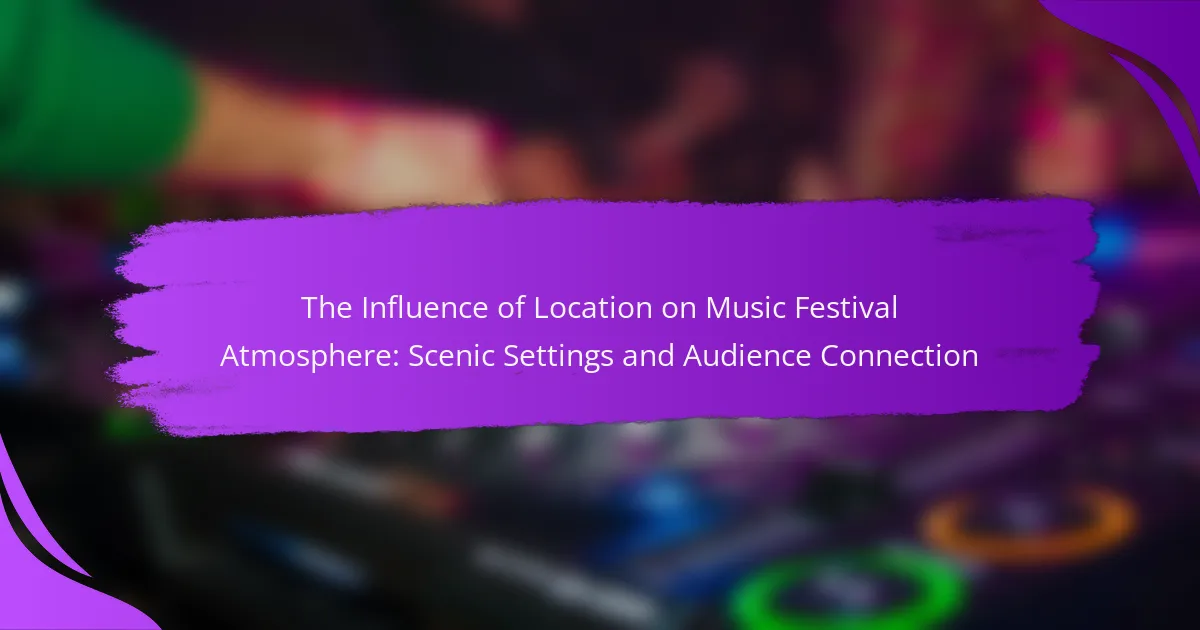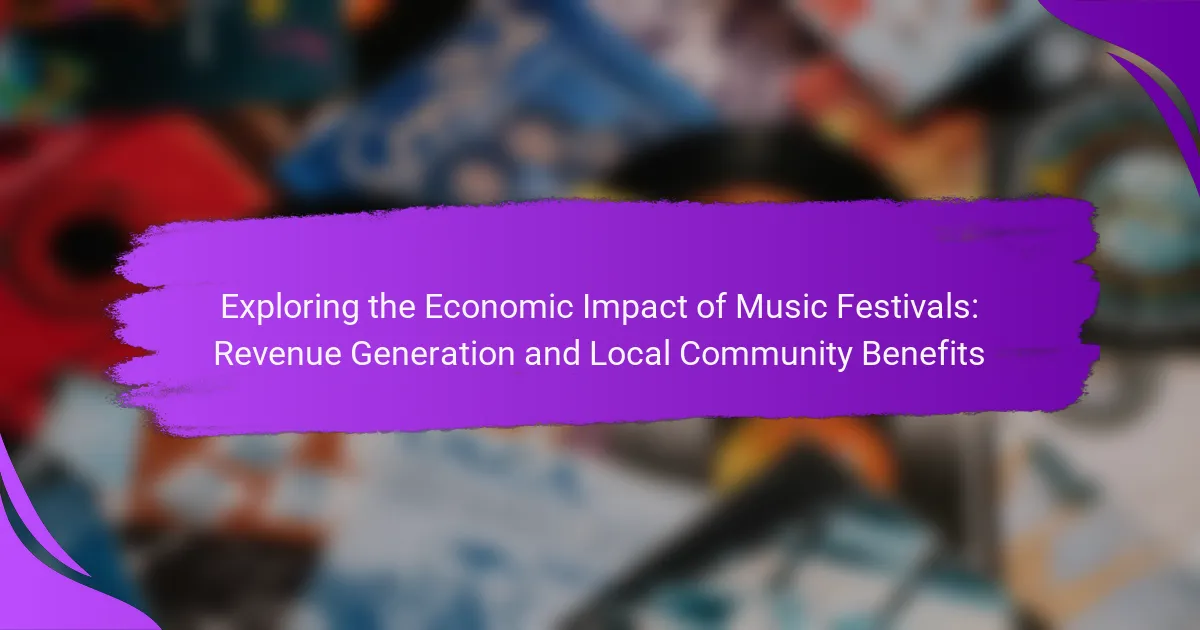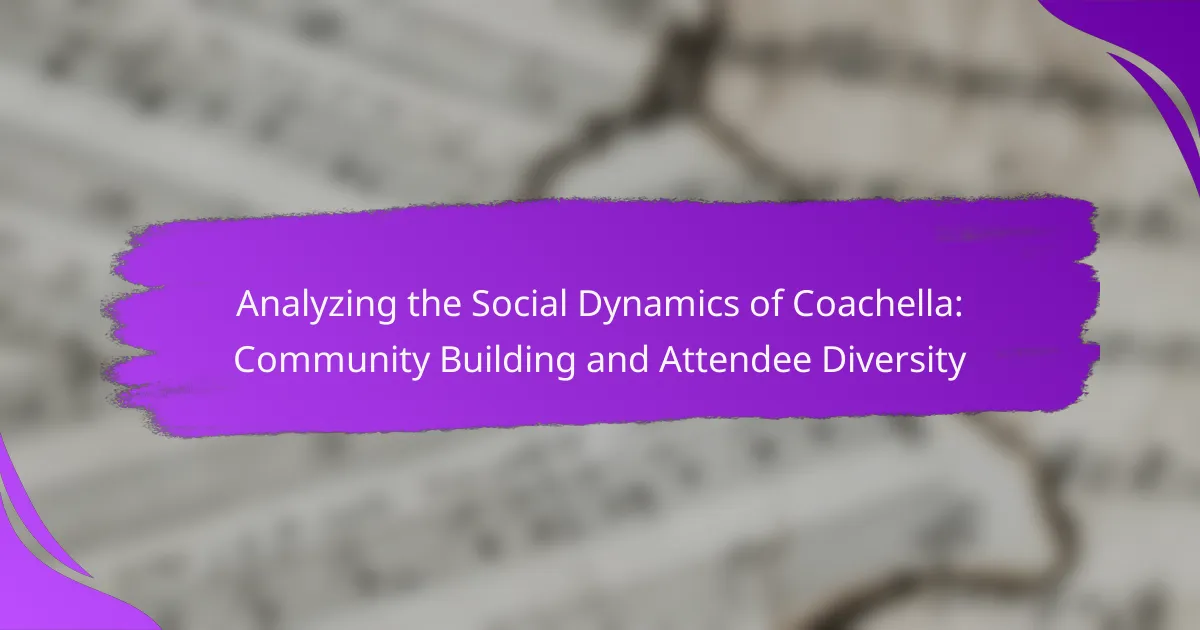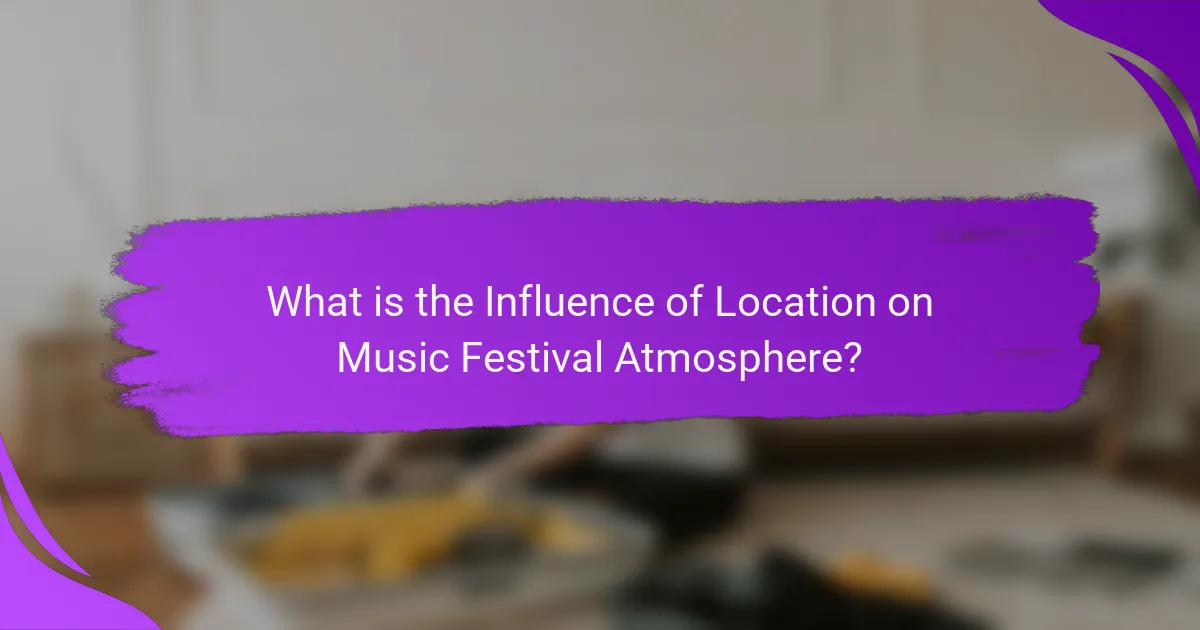
What is the Influence of Location on Music Festival Atmosphere?
Location significantly influences the atmosphere of music festivals. The setting determines the overall vibe and energy felt by attendees. For instance, festivals held in natural landscapes create a serene and immersive experience. Urban locations often generate a vibrant and energetic atmosphere due to the surrounding city life. Historical sites can evoke a sense of nostalgia and cultural appreciation. The accessibility of the location also impacts attendance and audience engagement. Festivals in remote areas may foster a sense of community among attendees. Conversely, easily accessible locations can attract larger crowds. Weather conditions tied to the location can further affect the mood and experience. For example, sunny weather can enhance enjoyment, while rain may dampen spirits. Overall, the location shapes the unique character and emotional connection of a music festival.
How do scenic settings impact the overall experience of music festivals?
Scenic settings significantly enhance the overall experience of music festivals. Natural landscapes create a unique atmosphere that influences audience enjoyment. Studies show that attendees report higher satisfaction levels in visually appealing environments. A scenic backdrop can elevate mood and engagement during performances. Events held in picturesque locations often attract larger crowds. For instance, festivals set in national parks or coastal areas tend to receive positive feedback. Scenic settings also provide opportunities for memorable photography and social media sharing. This visual appeal can enhance the festival’s reputation and encourage repeat attendance.
What are the key characteristics of an ideal location for a music festival?
An ideal location for a music festival features ample space, accessibility, and scenic beauty. Ample space accommodates large crowds and various stages. Accessibility ensures easy transportation for attendees, including parking and public transport options. Scenic beauty enhances the atmosphere, creating a memorable experience. Natural surroundings can elevate the aesthetic appeal and connection to the music. Proximity to amenities like food and restrooms is crucial for attendee comfort. Safety and security measures must be in place to protect festival-goers. Historical festivals like Coachella have thrived due to their picturesque locations and logistical planning. These characteristics collectively contribute to a successful and enjoyable music festival experience.
How does the environment contribute to audience emotions during performances?
The environment significantly influences audience emotions during performances. Factors such as lighting, sound quality, and venue design create an immersive experience. For example, warm lighting can evoke feelings of comfort and joy. Conversely, harsh lighting might induce anxiety or discomfort. The acoustics of a venue also play a crucial role; clear sound enhances emotional connection to the performance. Outdoor settings can further amplify emotions through natural elements like scenery and weather. Studies show that scenic backdrops positively impact audience enjoyment and engagement. A research study by Kahn and Heller (2018) found that natural environments increased emotional responses during live performances. Thus, the environment shapes emotional experiences during performances in multiple, measurable ways.
Why is audience connection crucial in music festivals?
Audience connection is crucial in music festivals because it enhances the overall experience for attendees. When audiences feel connected, they engage more deeply with the performances. This engagement can lead to increased emotional responses and memorable moments. Studies show that emotional connections at events can boost satisfaction levels significantly. Additionally, a strong audience connection fosters a sense of community among festival-goers. This sense of belonging can encourage attendees to return for future festivals. Moreover, positive audience experiences often translate into word-of-mouth promotion. This promotion can help attract larger crowds in subsequent years. Overall, audience connection directly impacts the success and longevity of music festivals.
What role does location play in fostering audience engagement?
Location significantly influences audience engagement by shaping the overall experience. Scenic settings enhance emotional connections and create memorable experiences. Studies show that festivals in picturesque locations attract larger crowds. Natural beauty can elevate mood and increase satisfaction among attendees. Proximity to urban centers also facilitates accessibility and convenience. Engaging environments encourage social interactions and community building. Unique local features can enhance the festival’s theme and brand identity. Overall, the right location fosters a deeper connection between the audience and the event.
How do scenic views enhance the sense of community among festival-goers?
Scenic views enhance the sense of community among festival-goers by providing a shared visual experience. When attendees are surrounded by beautiful landscapes, they tend to feel more connected to each other. This connection fosters social interactions and conversations among individuals. Research indicates that shared experiences in attractive environments can strengthen bonds. For instance, a study by Kaplan and Kaplan (1989) found that natural settings promote social cohesion. Scenic views also create a positive atmosphere, encouraging attendees to engage in group activities. This engagement further solidifies community ties among festival-goers.
What are the different types of scenic settings for music festivals?
Music festivals can take place in various scenic settings. Common types include outdoor parks, which provide natural landscapes and open spaces. Beaches offer a unique coastal vibe and scenic ocean views. Mountains create a dramatic backdrop and often cooler temperatures. Urban settings, like city streets or rooftops, provide a vibrant atmosphere with skyline views. Historic sites add cultural significance and charm to the festival experience. Each setting influences the festival’s atmosphere and audience connection. For instance, festivals held in nature often foster a sense of community and relaxation.
How do urban locations differ from rural settings in terms of atmosphere?
Urban locations have a dynamic and vibrant atmosphere compared to rural settings, which tend to be more tranquil and serene. Urban areas are characterized by higher population density, leading to a bustling environment filled with noise and activity. In contrast, rural settings offer open spaces and natural surroundings, contributing to a peaceful and relaxed atmosphere.
Urban locations often feature diverse cultural events and nightlife, enhancing social interactions and energy levels. This contrasts with rural areas, where community events may be less frequent and more localized. The architecture in urban settings, such as skyscrapers and modern venues, creates a unique backdrop that influences the overall vibe.
Additionally, urban atmospheres are often shaped by the presence of technology and media, which can amplify experiences at events. Conversely, rural settings provide a connection to nature, which can foster a sense of calm and connection to the environment. These differences significantly impact the atmosphere of music festivals held in either location.
What unique attributes do natural landscapes bring to music festivals?
Natural landscapes bring unique attributes to music festivals by enhancing the overall experience. They provide breathtaking scenery that captivates attendees. Natural elements like mountains, forests, and rivers create a tranquil atmosphere. This setting encourages relaxation and connection with nature. The visual beauty of landscapes can elevate the emotional impact of performances. Studies show that outdoor settings improve audience engagement. Additionally, natural acoustics in open spaces enhance sound quality. These attributes collectively foster a memorable festival experience.
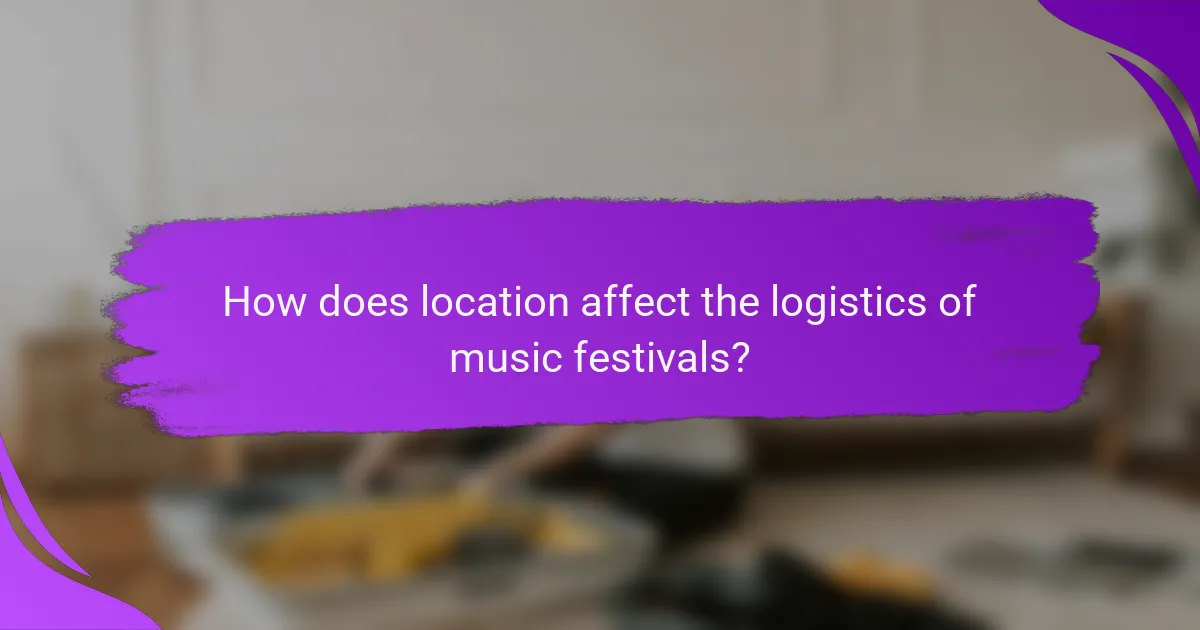
How does location affect the logistics of music festivals?
Location significantly affects the logistics of music festivals. The geographical setting determines accessibility for attendees. Proximity to major transportation hubs influences attendance rates. Urban locations often provide better infrastructure and services. Rural settings may require additional planning for transportation and accommodations. Weather patterns in specific locations can impact scheduling and safety measures. Local regulations and permits vary by location, affecting operational logistics. Additionally, the scenic quality of the location can enhance the festival experience, attracting more visitors. Historical examples show that festivals in scenic areas often see higher ticket sales and attendee satisfaction.
What logistical challenges arise from different festival locations?
Logistical challenges from different festival locations include transportation access, infrastructure limitations, and resource availability. Remote locations may lack adequate roads and public transport, making it difficult for attendees to arrive. Urban sites may have congestion and parking issues, complicating logistics. Infrastructure such as power supply, water access, and sanitation facilities can vary significantly. Some locations may not have the necessary amenities to support large crowds. Weather conditions can also pose challenges, affecting setup and safety. Additionally, local regulations may restrict festival operations, impacting scheduling and services. These factors collectively influence the planning and execution of music festivals.
How does accessibility impact audience turnout at music festivals?
Accessibility significantly impacts audience turnout at music festivals. When festivals are easily reachable, more attendees are likely to participate. Factors such as transportation options, parking availability, and venue layout play crucial roles. A study by the Event Safety Alliance indicates that festivals with good accessibility see up to 30% higher attendance. Furthermore, accessible facilities attract diverse audiences, including those with disabilities. This inclusivity enhances the overall experience and promotes community engagement. Festivals that prioritize accessibility can also benefit from positive word-of-mouth, further increasing turnout.
What are the considerations for sound and stage setup in various environments?
Sound and stage setup in various environments requires careful consideration of acoustics, audience layout, and equipment. Acoustics influence how sound travels and is perceived. Outdoor venues often face challenges like wind and open space, which can disperse sound. Indoor venues may have reflections and reverberations that affect clarity.
Audience layout impacts the placement of speakers and stage. A flat audience area may require more speakers to cover distance. A sloped area can enhance sound distribution. Equipment selection is crucial for different environments. Weatherproof gear is essential for outdoor settings.
Power supply and cabling must be managed effectively to avoid hazards. The setup should also consider sightlines, ensuring all attendees have a clear view of the stage. Safety regulations must be followed, particularly in large crowds. These factors collectively ensure optimal sound quality and audience experience.
How can organizers select the best location for their festival?
Organizers can select the best location for their festival by evaluating several key factors. First, they should consider accessibility for attendees, including transportation options and parking availability. Next, the location’s capacity to accommodate the expected audience size is crucial. Organizers must also assess the site’s infrastructure, such as restrooms, power supply, and water access. The surrounding environment plays a significant role in creating the festival atmosphere, so scenic settings with natural beauty are preferred. Additionally, local regulations and permits must be taken into account to ensure compliance. Weather patterns in the area should be evaluated to avoid adverse conditions during the event. Finally, organizers should consider the proximity to local amenities, such as hotels and restaurants, to enhance the overall experience for attendees.
What factors should be considered when evaluating potential locations?
Key factors to consider when evaluating potential locations for music festivals include accessibility, capacity, infrastructure, and surrounding environment. Accessibility refers to the ease of reaching the site, including transportation options. Capacity is the maximum number of attendees the location can accommodate comfortably. Infrastructure encompasses facilities such as restrooms, stages, and food vendors. Surrounding environment includes natural scenery and noise levels, which can enhance or detract from the festival atmosphere. Additionally, local regulations and community support are crucial for successful event execution. Each of these factors significantly impacts the overall experience and connection of the audience to the festival.
How do weather conditions influence location choice for music festivals?
Weather conditions significantly influence location choice for music festivals. Organizers consider climate patterns to ensure attendee comfort and safety. Festivals in warmer regions may be scheduled during milder months to avoid extreme heat. Rainfall can deter attendance, prompting organizers to select locations with historically lower precipitation rates. Sunny weather is often preferred for outdoor events, enhancing the overall experience. Additionally, local weather forecasts are monitored closely leading up to the event. For instance, festivals in areas prone to storms may have contingency plans in place. These decisions directly affect logistics, accessibility, and audience enjoyment.

What are the long-term effects of location on music festival success?
The long-term effects of location on music festival success include audience retention, brand reputation, and logistical challenges. A well-chosen location can enhance audience experience and encourage repeat attendance. Festivals held in scenic areas often attract larger crowds due to their appealing environments. The location also influences the festival’s branding and image, impacting partnerships and sponsorships. Moreover, accessibility affects attendance rates. Locations that are difficult to reach may deter potential attendees over time. Studies show that festivals in urban areas tend to maintain higher success rates due to better infrastructure and amenities.
How does a festival’s location contribute to its brand identity?
A festival’s location significantly contributes to its brand identity by shaping the overall experience it offers. The geographical setting influences the festival’s themes, activities, and audience engagement. For instance, a beach location may promote a laid-back atmosphere, while a mountainous region can evoke adventure and exploration.
Additionally, the local culture and community impact the festival’s branding. Festivals that incorporate local traditions can enhance authenticity and attract attendees interested in cultural experiences. Historical context also plays a role; a location with a rich musical heritage can elevate the festival’s prestige.
Research shows that attendees often associate specific locations with unique experiences. This connection can lead to increased loyalty and repeat attendance. Thus, the location not only defines the festival’s ambiance but also solidifies its brand identity in the minds of participants.
What impact does location have on repeat attendance and loyalty?
Location significantly impacts repeat attendance and loyalty at music festivals. A scenic and accessible location enhances the overall experience for attendees. Studies show that festivals held in picturesque settings attract more visitors. These locations create memorable experiences, increasing the likelihood of return attendance. Proximity to urban centers often boosts attendance due to convenience. Additionally, unique geographical features can enhance the festival’s brand. Festivals in desirable locations often report higher loyalty rates among attendees. This loyalty translates into repeat visits and positive word-of-mouth promotion.
How can location influence sponsorship and partnerships for festivals?
Location significantly influences sponsorship and partnerships for festivals. Proximity to urban centers often attracts larger brands seeking visibility. Festivals in scenic areas may appeal to sponsors focused on lifestyle and outdoor experiences. Local demographics can shape sponsorship opportunities based on target audience alignment. For instance, a festival in a tourist-heavy area may attract travel-related sponsors. Additionally, local culture and community values can enhance partnerships with regional businesses. Historical data shows that festivals in vibrant locations often secure more lucrative sponsorship deals. This correlation highlights the strategic importance of location in festival planning.
What best practices can organizers follow to leverage location for atmosphere?
Organizers can leverage location for atmosphere by choosing scenic settings that enhance the festival experience. Selecting locations with natural beauty, such as parks or beaches, can create a relaxing environment. Incorporating local culture into the festival can deepen audience connection. Using the landscape to inform stage design can enhance visual appeal. Organizers should consider accessibility to ensure all attendees can enjoy the atmosphere. Additionally, utilizing local vendors can enrich the sensory experience with regional flavors. Hosting activities that reflect the location’s unique attributes can engage attendees further. Finally, optimizing sound and lighting for the specific venue can elevate the overall ambiance.
How can festivals create immersive experiences based on their setting?
Festivals can create immersive experiences by leveraging their unique settings. The natural environment enhances the sensory experience for attendees. Scenic locations like beaches or mountains provide stunning backdrops that engage participants. The use of local culture and traditions enriches the festival atmosphere. Incorporating regional cuisine and art creates a deeper connection to the setting. Interactive installations can reflect the local landscape, making the experience more memorable. Soundscapes can be designed to harmonize with the natural surroundings. Studies show that immersive environments increase audience satisfaction and engagement. For example, a 2019 survey indicated that 75% of festival-goers felt more connected to events held in picturesque locations.
What strategies can enhance audience connection through location choices?
Selecting immersive locations enhances audience connection at music festivals. Scenic settings create emotional resonance. Natural landscapes evoke feelings of peace and joy. Urban environments can foster a sense of excitement and energy. Accessibility is crucial for audience participation. Easy access encourages higher attendance and engagement. Community involvement in location choice fosters a sense of belonging. This connection can enhance the overall festival experience. Historical festivals, like Woodstock, show how location influences audience engagement. They attracted large crowds due to their memorable settings.
The main entity of the article is the influence of location on the atmosphere of music festivals. The article examines how different settings, such as natural landscapes, urban environments, and historical sites, shape the overall vibe, audience engagement, and emotional connections during performances. Key factors discussed include the impact of scenic views on audience satisfaction, the logistical challenges posed by various locations, and the importance of accessibility in driving attendance. Additionally, the article highlights how location contributes to a festival’s brand identity and long-term success, emphasizing the role of immersive experiences in fostering community among attendees.
